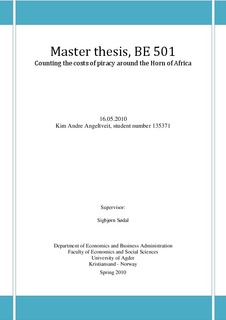| dc.description.abstract | This thesis has identified three key factors that are present in the hot spots of piracy around the world. A hot spot is typically very trafficated by international merchant ships, the local people are usually less fortunate, and the countries where the pirates are located, often have weak and corrupt governments.
It is shown how piracy around the Horn of Africa differs from piracy elsewhere. The pirates operate from a country, Somalia, which has been without an efficient government for almost two decades, and the gangs that control the country rule their territories as semi autonomous enclaves, so criminals can operate almost freely.
The Gulf of Aden is a part of the international maritime highway between Europe and Asia, and the trade between these two continents is now threaten by the pirates, and in worst case scenario the ships that provide transportation for the traded goods can be forced to avoid the area. The alternative route is longer, and fever roundtrips will be available per year. The delivery time will also be lengthen, fuel price and freight rates will peak and new demands related to ship design will influence the shipyards will be the results if every ship is forced to use this alternative route.
Piracy has been around for centuries, and experiences have been made. But newer laws and regulations makes it difficult to handle piracy in this area, and methods that previous have been efficient have not been as successful here as elsewhere. The issues with regulations and laws are described to better understand this problem.
Six methods, three at a government level, and three at a corporate level, are identified as the possible solutions to deal with, and relate to piracy around the Horn of Africa. All are used today to a somewhat degree. The costs of each of these methods are estimated to the degree possible, and compared with the effect it has. The methods are then evaluated against each other.
My analysis and evaluation finds that the best way for the governments to protect their shipping industry, is to back a Somali government conquering the difficulties that it needs to overcome in order to efficiently govern the country. This is a long process, and in the meantime pirates can be trialed in other countries, and serve their sentence in new prisons in Somalia. While the shipping companies wait for this to happen, the best way they can protect themselves is to hire armed forces to protect the ship when it is in transit. Evasive maneuvers have also proven efficient, but are not always enough. | en_US |
